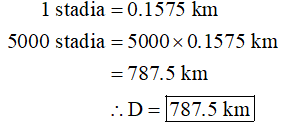3. Convert 5,000 stadia to kilometers. Again, you may use the following proportion: I stadia 0.1575 km 5,000 stadia D km (Hint: crossmukiplydivide) Thus, D= km. 4. Use the formula a = D/R to solve for R. Then us ing these values of a in radians (2), and D in kilometers (3), caleulate the value of the radius of the Earth, R, in kilometers. R km. 5. The radius of the Earth is known to be Rah =6378.1 km (accepted value). Was your calculation close to the accepted value? Find the percent error using this formula: % error = laccepted value – experimental value| /accepted value % error=
3. Convert 5,000 stadia to kilometers. Again, you may use the following proportion: I stadia 0.1575 km 5,000 stadia D km (Hint: crossmukiplydivide) Thus, D= km. 4. Use the formula a = D/R to solve for R. Then us ing these values of a in radians (2), and D in kilometers (3), caleulate the value of the radius of the Earth, R, in kilometers. R km. 5. The radius of the Earth is known to be Rah =6378.1 km (accepted value). Was your calculation close to the accepted value? Find the percent error using this formula: % error = laccepted value – experimental value| /accepted value % error=
College Physics
11th Edition
ISBN:9781305952300
Author:Raymond A. Serway, Chris Vuille
Publisher:Raymond A. Serway, Chris Vuille
Chapter1: Units, Trigonometry. And Vectors
Section: Chapter Questions
Problem 1CQ: Estimate the order of magnitude of the length, in meters, of each of the following; (a) a mouse, (b)...
Related questions
Question

Transcribed Image Text:BACKGROUND
An ingenious solution to the Earth's circumference occured in 230 BC. Eratosthenes, a Greek
geographer, mathematician, music theorist, poet, astronomer, and philosopher, was reading in the
Library of Alexandria when he noticed an account for a deep well near Syene (now Aswan),
some distance to the south (800 km) in which at high noon on the longest day of the year the
bottom of the well was fully illuminated by the Sun. Eratosthenes exclaimed "Ah-ah!" (or
something like that), "I can solve for the circumference of the Earth!". In his mind's eye,
Eratosthenes could see that at Syene, at the moment when the bottom of the well was fully lit, the
Sun must have been at the Zenith (directly overhead). Yet he knew that at the same moment in
Alexandria vertical objects (like a tower, pole) cast shadows.
Here is the experiment perfomed by Eratosthenes (see the picture below).
• He erected a vertical pole at Alexandria (A) and measured the angle of its shadow at the
moment when the well at Syene (S) was fully illuminated;
• The angle of the pole equaled the angle formed by the points Alexandria (A), Earth's
center (C), and Syene (S). That angle proved to be approximately a = 7°.
• The distance between Syene and Alexandria is 5,000 stadia (the units of measure at the
time). I stadia = 157.5 m=0.1575 km.
Figure 1. The measure of Earth's circumference is based on the assumption that
Syene is on the Tropic of Cancer and the same meridian as Alexandria. The
image is adapted from a similar image prepared by Gico (Wikimedia).

Transcribed Image Text:3. Convert 5,000 stadia to kilometers. Again, you may use the following proportion:
1 stadia
0.1575 km
5,000 stadia
Dkm (Hint: cros-multiply-divide)
Thus, D =
km.
4. Use the formula a = D/R to solve for R. Then using these values of a in radians (2), and
D in kilometers (3), caleulate the value of the radius of the Earth, R, in kilometers.
R =
km.
5. The radius of the Earth is known to be REath = 6378.1 km (accepted value). Was your
calculation close to the accepted value?
Find the percent error us ing this formula:
% eror = |accepted value – experimental value| / accepted value
% error =
Expert Solution
Step 1
Part 3
The conversion can be done as below,

Trending now
This is a popular solution!
Step by step
Solved in 3 steps with 3 images

Knowledge Booster
Learn more about
Need a deep-dive on the concept behind this application? Look no further. Learn more about this topic, physics and related others by exploring similar questions and additional content below.Recommended textbooks for you

College Physics
Physics
ISBN:
9781305952300
Author:
Raymond A. Serway, Chris Vuille
Publisher:
Cengage Learning

University Physics (14th Edition)
Physics
ISBN:
9780133969290
Author:
Hugh D. Young, Roger A. Freedman
Publisher:
PEARSON

Introduction To Quantum Mechanics
Physics
ISBN:
9781107189638
Author:
Griffiths, David J., Schroeter, Darrell F.
Publisher:
Cambridge University Press

College Physics
Physics
ISBN:
9781305952300
Author:
Raymond A. Serway, Chris Vuille
Publisher:
Cengage Learning

University Physics (14th Edition)
Physics
ISBN:
9780133969290
Author:
Hugh D. Young, Roger A. Freedman
Publisher:
PEARSON

Introduction To Quantum Mechanics
Physics
ISBN:
9781107189638
Author:
Griffiths, David J., Schroeter, Darrell F.
Publisher:
Cambridge University Press

Physics for Scientists and Engineers
Physics
ISBN:
9781337553278
Author:
Raymond A. Serway, John W. Jewett
Publisher:
Cengage Learning

Lecture- Tutorials for Introductory Astronomy
Physics
ISBN:
9780321820464
Author:
Edward E. Prather, Tim P. Slater, Jeff P. Adams, Gina Brissenden
Publisher:
Addison-Wesley

College Physics: A Strategic Approach (4th Editio…
Physics
ISBN:
9780134609034
Author:
Randall D. Knight (Professor Emeritus), Brian Jones, Stuart Field
Publisher:
PEARSON